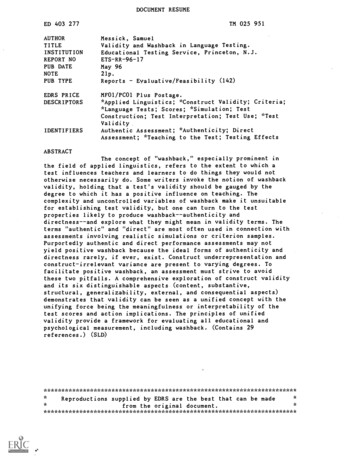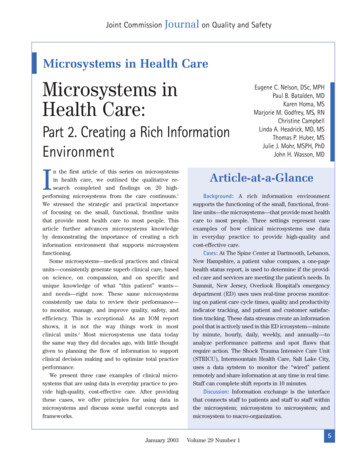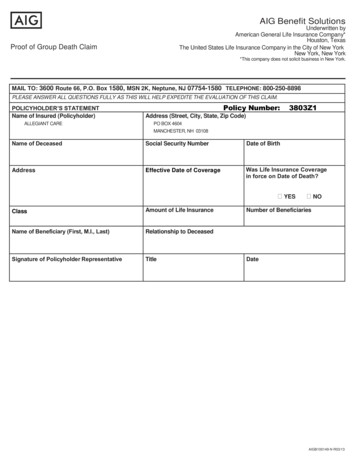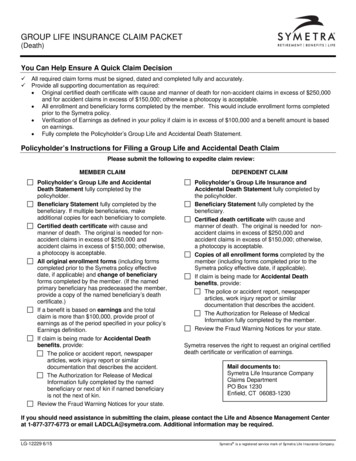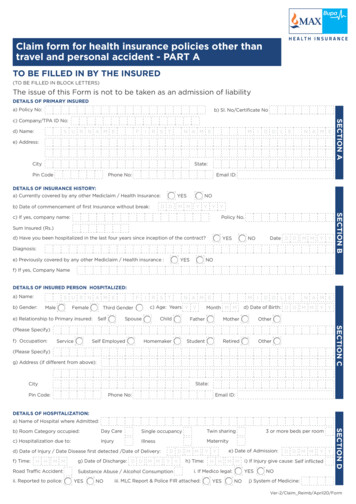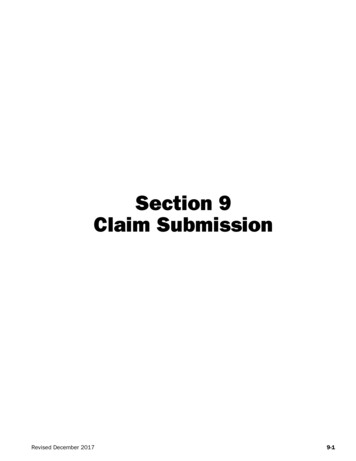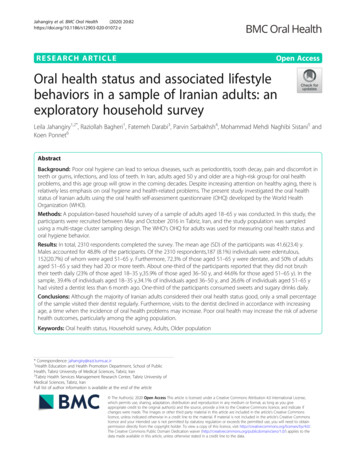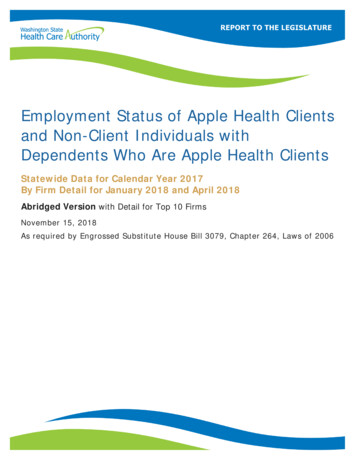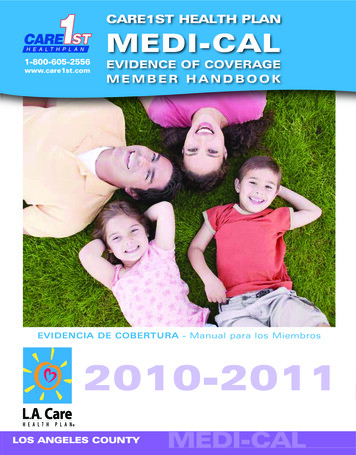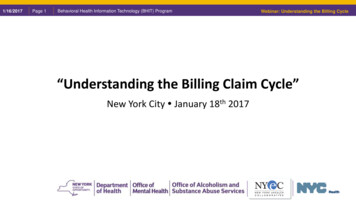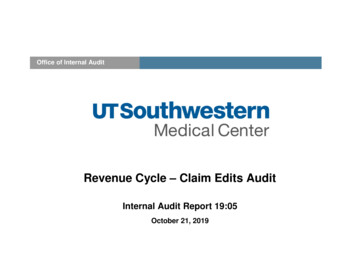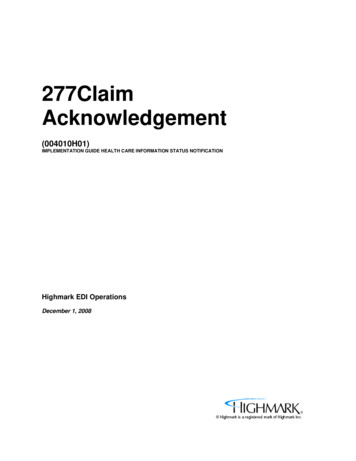
Transcription
277ClaimAcknowledgement(004010H01)IMPLEMENTATION GUIDE HEALTH CARE INFORMATION STATUS NOTIFICATIONHighmark EDI OperationsDecember 1, 2008
This page was intentionally left blank.
Highmark277 Claim Acknowledgement1 Purpose and BusinessOverview1.1 Document PurposeThe purpose of this implementation guide is to provide data requirements and content forreceivers of Highmark’s version of the 277 - Claim Acknowledgement Transaction (ANSI ASCX12.317). This implementation guide focuses on use of the 277 as an acknowledgement toreceipt of claim submission(s). This implementation guide provides a detailed explanation of thetransaction set by defining data content, identifying valid code tables and specifying valuesapplicable for the business focus of the 277 claim submission acknowledgement.Throughout this implementation guide the reference to "claim(s)" means individual claims orencounters or groupings of claims or encounters.Entities receiving this application of the 277 include, but are not limited to, hospitals, nursinghomes, laboratories, physicians, dentists, allied health professional groups, and supplemental(i.e., other than primary payer) health care claims adjudication processors.Other business partners affiliated with the 277 include billing services; consulting services;vendors of systems; software and EDI translators; EDI network intermediaries such as healthcare clearinghouses, value-added networks and telecommunication services.1.2 Version and ReleaseThis Highmark implementation guide is based on the October 1997 ASC X12 standard referredto as Version 4, Release 1, Sub-release 0 (004010). This is the first Highmark guide for thisbusiness function of the 277 Transaction set. For purposes of this business use, Highmark willidentify the Version of this Transaction in the GS08 data element as ‘004010H01’.1.3 Business UseThis implementation guide only addresses the business use of the 277 Claim Acknowledgement.The purpose of this transaction is to provide a system (application) level acknowledgement ofelectronic claims or encounters. This implementation guide is to be used specifically as anapplication acknowledgement response to the ASC X12N 837 Institutional and Professionalclaim/encounter submission transactions.This 277 Claim Acknowledgement transaction will only be used to acknowledge 837Institutional and Professional transactions where ISA08 54771. See the Payer ID Charts in theProfessional Claim (837P) and Institutional Claim (837I) sections of the Provider EDI ReferenceGuide for more specific payer information.1.3.1 Claim System AcknowledgementThe first level of acknowledgement by Highmark for the ASC X12 837 transactions will be theASC X12 Functional Acknowledgement (997) transaction. The 997 transaction is designed toRevised: 12/01/20083
Highmark277 Claim Acknowledgementnotify the submitter of the receiver’s ability or inability to process the entire 837 transactionbased on ASC X12 syntax and structure rules.The second level of acknowledgement by Highmark for the ASC X12 837 transaction will be the277 Claim Acknowledgement. This is a system (application) acknowledgement of the businessvalidity and acceptability of the claims. The level of editing in pre-adjudication programs willvary from system to system. Although the level of editing may vary, this transaction provides astandard method of reporting acknowledgements for claims. The application acknowledgementidentifies claims that are transferred to another entity, accepted for adjudication, as well as thosethat are not accepted. The 277 transaction is the only notification of pre-adjudication claimstatus. Claims failing the pre-adjudication editing process are not forwarded to the claimsadjudication system and therefore are never reported in the ASC X12 Health Care ClaimPayment/Advice (835) transaction. Claims passing the pre-adjudication editing process areforwarded to the claims adjudication system and handled according to claims processingguidelines. Final adjudication of claims is reported in the ASC X12 Health Care ClaimPayment/Advice (835) transaction.Revised: 12/01/20084
Highmark277 Claim Acknowledgement2 Data OverviewThis section introduces the structure of the 277 Claim Acknowledgement and describes thepositioning of the business data within the structure. Familiarity with ASC X12 nomenclature,segments, data elements, hierarchical levels, and looping structure is recommended. Refer toAppendix A of any national transaction set implementation guide named in the HIPAAAdministrative Simplification Electronic Transaction rule for information on ASC X12nomenclature, structure, etc.2.1 Overall Data ArchitectureThe implementation view provided at the beginning of Section 3 displays only the segments andtheir designated health care names described in this implementation guide. The intent of theimplementation view is to clarify the purpose and use of the segments.The 277 Transaction set is divided into two levels, or tables. Table 1 (Heading) containstransaction control information, which includes the ST and BHT segments. The ST segmentidentifies the start of a transaction’s business purpose. The BHT segment identifies thehierarchical structure used. Table 2 (Detail) contains the detail information for the businessfunction of the transaction. See Section 2.3 - Claim Status Theory for specific information onthe status reporting detail.2.2 Data ‘Usage’ DefinitionsWithin the Transaction detail, ‘Usage’ for the various Loops, Segments and Elements will bedefined as follows:Required - This item will always be used.Sit. (Situational) - The use of this item varies, depending on data content and business context.The defining rule is generally documented in syntax or usage notes attached to the item. *Theitem is used whenever the situation defined in the note is true; otherwise, the item is not used.Not Used - This item is not used. NOTE: If no situational note is present, the item may be sent if the data is available.Loop Usage: Loop usage within ASC X12 transactions can be confusing. Care must be used toread the loop requirements in terms of the context or location within the transaction. The usagedesignator of a loop’s beginning segment indicates the usage of the loop. Segments within a loopcannot be sent without the beginning segment of that loop.If the first segment is Required, the loop must occur at least once unless it is nested in a loop thatis not being used. A note on the Required first segment of a nested loop will indicate dependencyon the higher level loop. If the first segment is Situational, there will be a Segment Noteaddressing use of the loop. Any required segments in loops beginning with a Situational segmentonly occur when the loop is used. Similarly, nested loops only occur when the higher level loopis used.Revised: 12/01/20085
Highmark277 Claim Acknowledgement2.3 Claim Status TheoryThe level of information potentially available for a Claim Status Response may vary drasticallyfrom Payer to Payer. The primary vehicle for the claim status information in the 277 transactionis the STC segment.The STC segment contains three iterations of the Health Care Claim Status composite (C043)within elements STC01, STC10 and STC11. The standardized codes used in the compositeacknowledge the acceptance of the claim or specify the reason(s) for rejection. The compositeelements use industry codes from external Code Source 507, Health Care Claim Status CategoryCode, and Source 508, Health Care Claim Status Code. The primary distribution source for thesecodes is the Washington Publishing Company World Wide Web site (www.wpc-edi.com).Within the STC segment, composite element STC01 is required; STC10 and STC11 aresituational and used to provide additional claim status when needed. The composite elementconsists of three sub-elements.The first element in the composite is the Health Care Claim Status Category Code, Code Source507. The category code indicates the level of processing achieved by the claim. This element isRequired for use when the composite is used. For the business purpose of this implementationguide, only codes from the ‘Acknowledgment’ category are supported. The ‘Acknowledgment’Category Codes all begin with ‘A’.The second element is the Health Care Claim Status Code, Code Source 508. This elementprovides more detailed information about the rational for the claim or line item being in thecategory identified in the first element. This element is Required for use when the composite isused. Examples of status messages include "entity acknowledges receipt of claim/encounter,""missing/invalid data prevents payer from processing claim," and "business application currentlynot available."The third element in the composite is the Entity Identifier Code. The code in this elementidentifies the entity referred to in the second element (Status Code). The code list identifies anorganizational entity, a physical location, property, or an individual. This element is Situationalfor use when the composite is used. A list of appropriate Entity Identifier Code values is withinthe STC segment in Section 3.Revised: 12/01/20086
Highmark277 Claim Acknowledgement3 Transaction Set277 - Claim ameFunctional Group .IDSTBHTNameTransaction Set HeaderBeginning of Hierarchical TransactionReq.Des.RRMax.Use1112040NM1LOOP ID - 1000Submitter NameRPageNo.Pos.No.Seg.ID13010HLNameLOOP ID - 2000AInformation Source Hierarchical Level14050NM1LOOP ID – 2100AInformation Source NamePageNo.Pos.No.Seg.ID15010HLNameLOOP ID - 2000BInformation Receiver Hierarchical Level16050NM1LOOP ID – 2100BInformation Receiver NamePageNo.Pos.No.Seg.ID17010HLNameLOOP ID - 2000CProvider Hierarchical LevelNM1LOOP ID – 2100CBilling Provider eat1R1R11Detail:18050Revised: 12/01/2008Req.Des.Max.UseR1R1LoopRepeat 117
Highmark277 Claim 40HLDMGNameLOOP ID - 2000DSubscriber Hierarchical LevelDemographic Information22050NM1LOOP ID – 2100DSubscriber Name232427090100110TRNSTCREF2829110120REFDTPLOOP ID – 2200DClaim IdentificationStatus InformationClaim Identification Number forClearinghouses and Other TransmissionIntermediariesPayer Claim NumberDate or Time or Period30323536180190200210SVCSTCREFDTPLOOP ID – 2220DService InformationStatus InformationService IdentificationDate or Time or PeriodPageNo.Pos.No.Seg.ID3738010040HLDMGNameLOOP ID - 2000EDependent Hierarchical LevelDemographic Information39050NM1LOOP ID – 2100EDependent Name404144090100110TRNSTCREF4546110120REFDTPLOOP ID – 2200EClaim IdentificationStatus InformationClaim Identification Number forClearinghouses and Other TransmissionIntermediariesPayer Claim NumberDate or Time or s.Max.UseRS11R1SRS1 11SR12SRRR1 111LoopRepeat 11 1 1Detail:Req.Des.Max.UseSR11R1RRS1 11SR12LOOP ID – 2220EService InformationStatus InformationService IdentificationDate or Time or PeriodSRRR1 111SETransaction Set TrailerR1Seg.IDGENameFunctional Group TrailerReq.Des.RLoopRepeat 11 1 1Summary:PageNo.55Pos.No.280Revised: 12/01/2008Max.Use1LoopRepeat8
Highmark277 Claim ax Use:Purpose:Syntax Notes:Semantic GS07RequiredGS08Revised: 12/01/2008GS Functional Group Header005HeadingRequired1To indicate the beginning of a functional group and to provide control information123GS04 is the group date.GS05 is the group time.The data interchange control number GS06 in this header must be identical to thesame data element in the associated functional group trailer, 5*X*004010H01 Data Element SummaryDataElement NameAttributes479Functional Identifier CodeM ID 2/2Code identifying a group of application related transaction setsHNHealth Care Claim Status Notification (277)142Application Sender's CodeM AN 2/15Code identifying party sending transmission; codes agreed to by tradingpartners'54771'124Application Receiver's CodeM AN 2/15Code identifying party receiving transmission; codes agreed to by tradingpartnersThis will always be the Highmark assigned Trading Partner Number for theentity receiving this transaction.373DateM DT 8/8Date expressed as CCYYMMDD337TimeM TM 4/8Time expressed in 24-hour clock time as follows: HHMM, or HHMMSS, orHHMMSSD, or HHMMSSDD, where H hours (00-23), M minutes (00-59),S integer seconds (00-59) and DD decimal seconds; decimal seconds areexpressed as follows: D tenths (0-9) and DD hundredths (00-99)28Group Control NumberM N0 1/9Assigned number originated and maintained by the sender455Responsible Agency CodeM ID 1/2Code used in conjunction with Data Element 480 to identify the issuer of thestandardXAccredited Standards Committee X12480Version / Release / Industry Identifier CodeM AN 1/12Code indicating the version, release, subrelease, and industry identifier of theEDI standard being used, including the GS and GE segments; if code in DE455in GS segment is X, then in DE 480 positions 1-3 are the version number;positions 4-6 are the release and subrelease, level of the version; and positions7-12 are the industry or trade association identifiers (optionally assigned byuser); if code in DE455 in GS segment is T, then other formats are allowed'004010H01'9
Highmark277 Claim ax Use:Purpose:Syntax Notes:Semantic d: 12/01/2008ST Transaction Set Header010DetailRequired1To indicate the start of a transaction set and to assign a control number1The transaction set identifier (ST01) is used by the translation routines of theinterchange partners to select the appropriate transaction set definition (e.g., 810selects the Invoice Transaction Set).Example: ST*277*0001 Data Element SummaryDataElement NameAttributes143Transaction Set Identifier CodeM ID 3/3Code uniquely identifying a Transaction Set277Health Care Claim Status Notification329Transaction Set Control NumberM AN 4/9Identifying control number that must be unique within the transaction setfunctional group assigned by the originator for a transaction setThe Transaction Set Control Numbers in ST02 and SE02 will be identical. Thisunique number also aids in error resolution research. Submitter could beginsending transactions using the number 0001 in this element and increment fromthere. The number must be unique within a specific functional group (GS toGE) and interchange (ISA to IEA), but can be repeated in other groups andinterchanges.10
Highmark277 Claim ax Use:Purpose:Syntax Notes:Semantic iredBHT03BHT Beginning of Hierarchical Transaction020DetailRequired1To define the business hierarchical structure of the transaction set and identify thebusiness application purpose and reference data, i.e., number, date, and time1BHT03 is the number assigned by the originator to identify the transaction within theoriginator's business application system.2 BHT04 is the date the transaction was created within the business applicationsystem.3 BHT05 is the time the transaction was created within the business applicationsystem.Example: BHT*0010*06**20020118**TH Data Element SummaryDataElement NameAttributes1005Hierarchical Structure CodeM ID 4/4Code indicating the hierarchical application structure of a transaction set thatutilizes the HL segment to define the structure of the transaction set0010Information Source, Information Receiver, Provider ofService, Subscriber, Dependent353Transaction Set Purpose CodeM ID 2/2Code identifying purpose of transaction set06Confirmation127Reference IdentificationO AN 1/30Reference information as defined for a particular Transaction Set or asspecified by the Reference Identification QualifierWhen a single 837 transaction (ST-SE) is submitted to Highmark in a FunctionalGroup envelope (GS-GE), the Originator Application Transaction Identifier(BHT03) from the 837 being acknowledged is reported in this element.When multiple 837 transactions (ST-SE) are submitted to Highmark in a singleFunctional Group envelope (GS-GE), one 277 Claim Acknowledgementtransaction will be returned acknowledging all the 837 transactions in thatFunctional Group. The Originator Application Transaction Identifier (BHT03)from the first 837 will be placed in this element.RequiredBHT04373Not UsedBHT05337RequiredBHT06640Revised: 12/01/2008DateO DT 8/8Date expressed as CCYYMMDDTimeO TM 4/8Time expressed in 24-hour clock time as follows: HHMM, or HHMMSS, orHHMMSSD, or HHMMSSDD, where H hours (00-23), M minutes (00-59),S integer seconds (00-59) and DD decimal seconds; decimal seconds areexpressed as follows: D tenths (0-9) and DD hundredths (00-99)Transaction Type CodeO ID 2/2Code specifying the type of transactionTHReceipt Acknowledgment Advice11
Highmark277 Claim AcknowledgementNM1Position:Loop:Level:Usage:Max Use:Purpose:Syntax Notes:Semantic Notes:Notes:Segment:Submitter Name0401000RequiredDetailRequired1To supply the full name of an individual or organizational entity1 If either NM108 or NM109 is present, then the other is required.2 If NM111 is present, then NM110 is required.1 NM102 qualifies NM103.Example: NM1*41*2*HIGHMARK*****NI*54771 Data Element SummaryDataElement NameAttributes98Entity Identifier CodeM ID 2/3Code identifying an organizational entity, a physical location, property or anindividual41SubmitterEntity transmitting transaction set1065Entity Type QualifierM ID 1/1Code qualifying the type of entity2Non-Person Entity1035Sender NameO AN 1/35Individual last name or organizational name"Highmark"1036Name FirstO AN 1/25Individual first name1037Name MiddleO AN 1/25Individual middle name or initial1038Name PrefixO AN 1/10Prefix to individual name1039Name SuffixO AN 1/10Suffix to individual name66Identification Code QualifierX ID 1/2Code designating the system/method of code structure used for IdentificationCode (67)NINational Association of Insurance Commissioners(NAIC) Identification67Identification CodeX AN 2/80Code identifying a party or other redNM103Not UsedNM104Not UsedNM105Not UsedNM106Not UsedNM107RequiredNM108RequiredNM109Not UsedNM110706Not UsedNM11198Revised: 12/01/2008Entity Relationship CodeX ID 2/2Code describing entity relationshipEntity Identifier CodeO ID 2/3Code identifying an organizational entity, a physical location, property or anindividual12
Highmark277 Claim ax Use:Purpose:Syntax Notes:Semantic Notes:Notes:HL Information Source Hierarchical Level0102000ARequiredDetailRequired1To identify dependencies among and the content of hierarchically related groups of datasegmentsThere will only be one Information Source (Payer) per 277. All claims within a specific277 were submitted to a single payer.Example: HL*1**20*1 Data Element SummaryDataElement NameAttributes628Hierarchical ID NumberM AN 1/12A unique number assigned by the sender to identify a particular data segment ina hierarchical structureHL01 will begin with the value "1" and increment by one each time an HL isused in the transaction. Only numeric values will be sent in HL01.RequiredRef.Des.HL01Not UsedHL02734RequiredHL03735RequiredHL04736Revised: 12/01/2008Hierarchical Parent ID NumberO AN 1/12Identification number of the next higher hierarchical data segment that the datasegment being described is subordinate toHierarchical Level CodeM ID 1/2Code defining the characteristic of a level in a hierarchical structure20Information SourceIdentifies the payor, maintainer, or source of theinformationHierarchical Child Cod
277Claim . Acknowledgement (004010H01) IMPLEMENTATION GUIDE HEALTH CARE INFORMATION STATUS NOTIFICATION . Highmark EDI Operations . December 1, 2008
